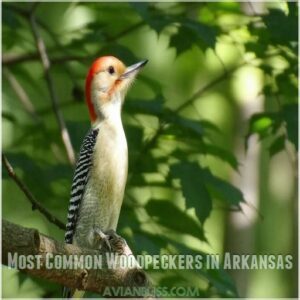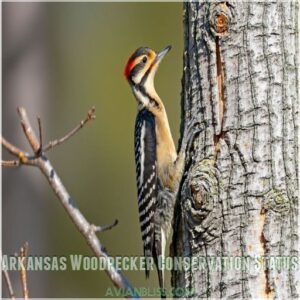This site is supported by our readers. We may earn a commission, at no cost to you, if you purchase through links.
 You’ll find eight woodpecker species thriving in Arkansas’s diverse landscapes, from the tiny Downy to the crow-sized Pileated woodpecker.
You’ll find eight woodpecker species thriving in Arkansas’s diverse landscapes, from the tiny Downy to the crow-sized Pileated woodpecker.
These remarkable birds, nature’s original power-tool enthusiasts, create unique drumming patterns that echo through Arkansas’s forests, suburbs, and parks.
They’re perfectly adapted to the Natural State’s mix of pine and hardwood forests, with specialized beaks and shock-absorbing skulls that let them drill into trees at an astounding 20 times per second.
Each species has its own personality and preferences, from the common Red-bellied woodpecker‘s backyard visits to the elusive Red-cockaded woodpecker’s pine forest hideaways.
Table Of Contents
- Key Takeaways
- Woodpeckers of Arkansas Overview
- Types of Woodpeckers in Arkansas
- Physical Characteristics of Arkansas Woodpeckers
- Arkansas Woodpecker Nesting Habits
- What Do Arkansas Woodpeckers Eat?
- Most Common Woodpeckers in Arkansas
- Rarest Woodpeckers in Arkansas
- Woodpecker Behavior and Communication
- Arkansas Woodpecker Conservation Status
- Attracting Woodpeckers to Your Arkansas Yard
- Frequently Asked Questions (FAQs)
- Are there woodpeckers in Arkansas?
- Are Lewis’s woodpeckers rare in Arkansas?
- How do woodpeckers communicate in Arkansas?
- Why are woodpeckers declining in Arkansas?
- How do you know if a woodpecker is in Arkansas?
- Are red-headed woodpeckers common in Arkansas?
- What is the most common woodpecker in Arkansas?
- Is it good to have woodpeckers in your yard?
- What does it mean when a woodpecker is in your yard?
- How do you tell the difference between a downy woodpecker and a hairy woodpecker?
- How do woodpeckers prevent brain damage while pecking?
- Do Arkansas woodpeckers migrate during winter months?
- Which predators commonly hunt Arkansas woodpeckers?
- How long do woodpeckers typically live in Arkansas?
- What diseases commonly affect woodpeckers in Arkansas?
- Conclusion
Key Takeaways
- You’ll find eight woodpecker species in Arkansas, from the tiny 0.8-ounce Downy to the crow-sized 10.5-ounce Pileated, with the Red-bellied being the most common visitor to backyard feeders.
- You can identify each species by their unique traits – males often show red patches on their heads, and they create distinctive drumming patterns that serve as both communication and territory marking.
- You’ll help attract woodpeckers to your yard by providing suet feeders, such as those with squirrel-proof designs, leaving dead trees standing when safe, and installing nesting boxes at different heights.
- You should note that while six species are thriving, the Red-cockaded Woodpecker remains critically endangered due to habitat loss, and the Ivory-billed Woodpecker is presumed extinct.
Woodpeckers of Arkansas Overview
You’ll find eight remarkable woodpecker species in Arkansas’s diverse landscapes, from the tiny downy woodpecker weighing just 0.8 ounces to the impressive pileated woodpecker at 10.5 ounces.
Whether you’re watching from your backyard or exploring the state’s 52 parks, you can spot these fascinating birds year-round.
The red-bellied woodpecker is the most common visitor to backyard feeders and the red-cockaded woodpecker is the rarest sight.
Arkansas Woodpecker Species
From the dense pine forests, where you can find many woodpeckers similar to those in North Carolina’s woodpecker habitats, to suburban backyards, Arkansas is home to eight fascinating woodpecker species.
You’ll find these remarkable birds across the state, each with unique characteristics and behaviors.
Here’s what makes Arkansas’s woodpeckers special:
- Two species are year-round residents
- Three species follow seasonal migration patterns
- Some species are making impressive comebacks
- Others face critical conservation challenges
Want to identify them? Let’s explore each species in detail.
Woodpecker Habitat in Arkansas
Arkansas’s diverse landscapes offer woodpeckers a perfect home, from pine forests to urban parks.
You’ll find these fascinating birds thriving in various environments across the state’s 52 parks and natural areas.
Here’s where you’re likely to spot different species:
| Habitat Type | Common Woodpeckers Found. The state’s diverse landscape supports a wide range of species, including the Red-Headed Woodpecker, with its distinctive vivid red head and neck |
|---|---|
| Pine Forests | Red-cockaded, Pileated |
| Oak Woodlands | Red-bellied, Hairy |
| Urban Areas | Downy, Northern Flicker |
| River Bottoms | Yellow-bellied Sapsucker |
| Dead Trees | Red-headed, Most Species |
Woodpecker Abundance and Rarity in Arkansas
Looking to spot woodpeckers in Arkansas? You’ll likely encounter the red-bellied woodpecker, which thrives across various habitats.
The ivory-billed woodpecker, once native to the region, was known for its distinctive ivory-colored bill characteristics.
The red-headed and red-cockaded woodpeckers have become increasingly rare due to habitat loss, with the red-cockaded being critically endangered.
While the ivory-billed woodpecker is considered extinct in Arkansas, occasional unconfirmed sightings still spark hope among local bird enthusiasts and conservationists.
Types of Woodpeckers in Arkansas
Eight fascinating woodpecker species, like those found in Massachusetts where the Downy Woodpecker is the smallest species with males having a red spot on the back of their heads, learn more about woodpeckers of massachusetts. call Arkansas home, each with its own unique character and habits.
You’ll spot the Northern Flicker hunting for ants on the ground, while the Red-bellied Woodpecker might stop by your backyard feeder. The Yellow-bellied Sapsucker‘s perfectly aligned holes in tree bark reveal its presence, and the tiny Downy Woodpecker often visits suburban gardens.
The Golden-Fronted Woodpecker, identifiable by its golden forehead markings, can also be found in the state’s dry, open woodlands.
If you’re lucky, you might glimpse the rare Red-cockaded Woodpecker in pine forests, or catch the Hairy Woodpecker during winter months. The Red-headed Woodpecker‘s population has declined recently, making sightings increasingly special.
While the legendary Ivory-billed Woodpecker was once native to Arkansas, it’s now considered extinct, though occasional unconfirmed sightings still spark hope among bird enthusiasts across the state.
Physical Characteristics of Arkansas Woodpeckers
You’ll find that Arkansas woodpeckers range from the tiny downy woodpecker at just 0.8 ounces to the mighty pileated woodpecker weighing 10.5 ounces.
Each species sports its own unique pattern of black and white feathers, with males often showing distinctive red patches on their heads or necks that you can spot from your backyard.
Size and Weight of Arkansas Woodpeckers
Woodpecker sizes in Arkansas range from tiny to impressive, with each species perfectly built for its lifestyle.
The smallest member of the family, the downy woodpecker, weighs just 0.8 ounces – about as much as a AA battery.
Here’s how they stack up:
- Pileated woodpecker: The heavyweight champ at 10.5 ounces, stretching 17.5 inches long
- Northern flicker: A mid-sized marvel at 4.7 ounces and 11.6 inches
- Red-bellied woodpecker: A comfortable 2.5 ounces
- Downy woodpecker: Our pocket-sized friend at 0.8 ounces
Plumage Patterns and Colors
Nature’s artistry shines through Arkansas woodpeckers’ distinctive plumage patterns.
You’ll spot these feathered friends by their unique color combinations and markings, which help identify males from females and juveniles from adults.
| Species | Male Colors | Female Colors | Seasonal Change | Notable Pattern |
|---|---|---|---|---|
| Northern Flicker | Red/Yellow Shafts | Duller Shafts | Minimal | Spotted Breast |
| Red-bellied | Red Crown & Nape | Red Nape Only | None | Zebra Back |
| Downy | Red Patch Present | No Red Patch | None | Spotted Wings |
| Yellow-bellied | Red Crown & Throat | Yellow Throat | Brighter in Spring | Ladder Back |
| Red-cockaded | Red Cockade | No Cockade | None | White Cheek |
Beak Shapes and Sizes
Arkansas’s wild woodpeckers show off their specialized beaks like a master carpenter’s toolbox.
You’ll notice their beaks are straight, chisel-shaped, and incredibly sturdy – perfect for drilling into wood.
The largest beak belongs to the Pileated Woodpecker, measuring up to 2 inches long, while the tiny Downy Woodpecker’s beak is barely half an inch, yet both are remarkably efficient at excavating wood.
Arkansas Woodpecker Nesting Habits
You’ll find that Arkansas woodpeckers are skilled home builders, spending up to three weeks carving out their nesting cavities in dead trees, with the red-cockaded woodpecker being the family rebel who prefers living pines.
Inside these natural apartments, you won’t see any fancy furnishings – just a simple bed of wood chips where both parents take turns incubating their eggs, with dad working the night shift.
Excavation and Construction of Nesting Cavities
Building a home takes serious dedication when you’re a woodpecker. These skilled carpenters spend anywhere from 2-3 weeks crafting their perfect cavity, with red-cockaded woodpeckers taking up to a year in live pine trees. You can even get inspiring ideas for your own backyard from an Arkansas woodpecker nest.
Here’s what makes their excavation process fascinating: They don’t bring in nesting materials – wood chips from excavation create the nest bed Both parents share construction duties, taking turns chipping away * Dead wood is preferred by most species, except red-cockaded woodpeckers who choose living pines
Entrance Hole Size and Shape
Like fingerprints unique to each species, woodpecker entrance holes tell a fascinating story of adaptation and survival.
You’ll notice these precise circular openings vary greatly among Arkansas’s woodpeckers, perfectly sized to welcome their builders while keeping predators at bay.
| Species | Entrance Hole Size | Shape | Height from Ground | Purpose |
|---|---|---|---|---|
| Pileated | 3-4 inches | Oval | 15-70 feet | Predator defense |
| Northern Flicker | 2.5 inches | Round | 6-15 feet | Easy access |
| Red-bellied | 2 inches | Circular | 5-70 feet | Size exclusion |
| Downy | 1-1.5 inches | Round | 8-50 feet | Small predator protection |
| Red-cockaded | 1.5-2 inches | Round | 20-60 feet | Sap flow control |
What Do Arkansas Woodpeckers Eat?
You’ll find that Arkansas woodpeckers have surprisingly diverse dining preferences, from the northern flicker’s ground-based ant feasts to the yellow-bellied sapsucker’s tree sap specialties.
While most Arkansas woodpeckers focus on insects hiding beneath tree bark, you might spot a red-bellied woodpecker enjoying fruits and nuts at your backyard feeder.
Typical Woodpeckers’ Diet and Foraging Habits
Most Arkansas woodpeckers seek out their meals by drumming and pecking through tree bark, revealing hidden insects beneath.
You’ll often spot these skilled foragers following a systematic pattern as they work their way around tree trunks.
Here’s what makes up their daily menu:
- Wood-boring beetles and larvae tucked under bark
- Carpenter ants nesting in dead wood
- Tree-dwelling caterpillars and other soft-bodied insects
Flickers’ Ground-Dwelling Diet
Northern Flickers stand out from other woodpeckers with their unique ground-foraging habits. You’ll spot these fascinating birds hopping along lawns and fields, probing the soil for their favorite meal: ants.
This adaptability in their diet is a strong indicator of the importance of variety in bird diets, which includes a range of food sources like seeds and insects.
| Season | Primary Diet | Foraging Location |
|---|---|---|
| Spring | Ants, Beetles | Open Ground |
| Summer | Ants, Larvae | Forest Floor |
| Fall | Seeds, Fruit | Mixed Areas |
| Winter | Berries, Insects | Brush Piles |
| Migration | Mixed Diet | Various |
These resourceful birds can consume thousands of ants daily, using their sticky tongue to capture prey.
Sapsuckers’ Sap-Drinking Diet
The yellow-bellied sapsucker‘s unique feeding strategy sets them apart from other Arkansas woodpeckers.
You’ll spot their distinctive rows of shallow holes, called sap wells, drilled precisely in tree bark.
These clever birds don’t just drink the sweet sap – they also catch insects attracted to these sticky traps.
To attract and learn more about the sapsuckers, check out Arkansas sapsucker gifts and items.
During migration, they’ll supplement their diet with wild berries and fruit when available.
Most Common Woodpeckers in Arkansas
You’ll often spot woodpeckers with distinctive rectangular holes woodpeckers of maryland, red-bellied woodpeckers, downy woodpeckers, and northern flickers in your Arkansas backyard, as they’re the most frequently seen woodpecker species in the state.
These feathered friends will visit your yard throughout the year, especially if you’ve got mature trees or a well-stocked bird feeder.
Red-Bellied Woodpeckers
Adaptable and sociable, red-bellied woodpeckers have become backyard celebrities across Arkansas. You’ll spot these medium-sized birds drumming on trees year-round, with their distinctive red caps catching the sunlight.
Here’s what makes them stand out:
- They’re not picky eaters, enjoying everything from insects to wild berries
- Males and females share the same territory all year
- Both parents take turns incubating eggs
- They’ll return to the same nesting tree annually
Downy Woodpeckers
Among Arkansas’s smallest woodpeckers, these feathered friends pack a mighty personality into their tiny frames.
You’ll spot them darting between branches, making sharp ‘peek’ calls that echo through the trees.
Here’s what makes them unique:
| Feature | Male | Female |
|---|---|---|
| Crown | Red patch | Black |
| Size | 6-7 inches | 6-7 inches |
| Weight | 0.8 oz | 0.8 oz |
| Coloring | Black & white | Black & white |
| Behavior | More vocal | Less vocal |
Northern Flickers
Moving up from our tiny Downy friend, Northern Flickers stand out as nature’s ground-feeding specialists.
You’ll spot these striking woodpeckers foraging in your lawn, unlike their tree-climbing cousins.
Here’s what makes them unique:
- They’re ant-hunting experts, consuming thousands daily
- Their flecked pattern resembles scattered starlight
- They produce a distinctive "wicka-wicka-wicka" call
- Their migration patterns stretch from Alaska to Panama
Watch for their yellow or red wing flashes as they probe the earth for insects.
Rarest Woodpeckers in Arkansas
You’ll find that Arkansas’s rarest woodpeckers, including the critically endangered red-cockaded woodpecker and the declining red-headed woodpecker, need special attention to spot in the wild.
While you might get lucky enough to see these elusive birds in specific habitats across the state, keep in mind that the legendary ivory-billed woodpecker hasn’t been conclusively documented here since its reported extinction.
Red-Cockaded Woodpeckers
The endangered red-cockaded woodpecker stands out as Arkansas’s rarest woodpecker species.
You’ll spot these small birds by their distinctive white cheeks and black-and-white striped backs.
As cooperative breeders in mature pine, they work together to excavate nest cavities in live pine trees.
Unlike their cousins who prefer dead trees, they’re the only woodpeckers that carve homes in living pine trees.
It’s a time-consuming process – they’ll spend up to a year excavating their perfect cavity nest!
Red-Headed Woodpeckers
Red-headed woodpeckers have faced a steep decline in Arkansas, with their striking crimson heads becoming an increasingly rare sight.
Red-headed woodpeckers prefer open woodlands where they can cache acorns and beechnuts for later snacking.
Unlike their cousins, they’re skilled aerial hunters, snatching insects mid-flight.
Their population drop is linked to habitat loss and competition for nesting cavities with European starlings.
Ivory-Billed Woodpeckers
While extinct in Arkansas, the ivory-billed woodpecker’s story continues to captivate birders and scientists alike.
Last confirmed in the 1940s in Louisiana’s Singer Tract, this magnificent bird hasn’t been officially documented since.
You might hear whispers of recent sightings in Arkansas’s bottomland forests, but despite extensive searches and a $50,000 reward, conclusive evidence remains elusive.
Its legacy serves as a powerful reminder of conservation’s importance.
Woodpecker Behavior and Communication
You’ll notice Arkansas woodpeckers use a fascinating mix of drumming patterns, calls, and physical displays to communicate with potential mates and defend their territories.
When you’re near their habitat, you can observe these skilled drummers tapping out unique rhythms on tree trunks, hollow branches, and even metal surfaces to send messages across the forest.
Drumming and Calling Patterns
Drumming patterns of Arkansas woodpeckers tell a fascinating story of their daily lives.
You’ll hear these skilled percussionists communicate through distinct rhythms and calls, each serving a specific purpose:
- Quick, staccato drumming signals territory boundaries
- Single, sharp "peek" calls warn of nearby predators
- Rapid drumming bursts, lasting 1-2 seconds, help locate family members
These unique sound signatures help you identify which species is visiting your backyard.
Mating and Courtship Displays
During spring’s awakening, Arkansas woodpeckers put on quite the romantic show. You’ll witness spectacular courtship displays that’ll make your backyard feel like nature’s dance floor.
| Species | Courtship Display | Unique Mating Call |
|---|---|---|
| Red-bellied | Head-swinging dance | Quick "churr-churr" |
| Downy | Wing-spreading bow | Soft "pik" notes |
| Northern Flicker | Bill fencing ritual | Musical "wicka" |
| Pileated | Branch drumming | Long "cuk-cuk-cuk" |
The males typically initiate these courtship rituals with distinctive drumming patterns, followed by elegant aerial displays that showcase their vibrant plumage.
Territorial Behavior
Three distinct behaviors mark woodpeckers’ territorial nature in Arkansas: aggressive displays, persistent drumming, and vocal warnings.
You’ll notice these feisty birds fiercely defend their nesting sites and feeding areas, especially during breeding season, with some species forming lifelong pair bonds.
They’ll chase away rivals with distinctive wing-spreading displays and loud calls.
Some species, like the red-bellied woodpecker, even maintain year-round territories through strategic drumming patterns.
Arkansas Woodpecker Conservation Status
You’ll find that six of Arkansas’s eight woodpecker species are thriving, while the red-cockaded woodpecker remains critically endangered and the ivory-billed woodpecker is presumed extinct.
Important forest habitats and essential nesting sites for these woodland drummers.
If you’re interested in helping these remarkable birds, you can join local conservation efforts that protect important forest habitats and provide essential nesting sites for these woodland drummers.
Threats to Woodpecker Populations
You’ll find Arkansas woodpeckers facing mounting challenges in their natural habitats.
The biggest threats include habitat loss from urban development and logging, particularly affecting the red-cockaded woodpecker’s old-growth pine forests.
Climate change disrupts breeding patterns and food availability, while pesticide use reduces insect populations.
Disease outbreaks and competition from invasive birds for nesting cavities further stress these remarkable creatures.
Conservation Efforts
Conservationists in Arkansas have launched ambitious programs to protect woodpecker populations.
Working with landowners, they’ve established guidelines for sustainable logging that preserve old-growth trees – prime real estate for our feathered friends.
Additionally, supporters can purchase woodpecker-themed products from organizations like Arkansas woodpecker conservation to help fund conservation efforts.
Forest management teams now monitor nesting sites year-round, while citizen scientists contribute valuable data through bird counts.
Thanks to these efforts, several woodpecker species are showing promising signs of recovery.
Endangered Woodpecker Species
Among Arkansas’s woodpeckers, the red-cockaded woodpecker faces the greatest risk of extinction, with populations dwindling due to habitat loss and climate change.
They’re particularly vulnerable because they only nest in living pine trees, making their survival closely tied to old-growth forests.
While illegal logging threatens their remaining habitats, dedicated conservation areas in Arkansas provide hope for this endangered species’ recovery.
Attracting Woodpeckers to Your Arkansas Yard
You’ll discover that transforming your Arkansas backyard into a woodpecker sanctuary isn’t rocket science when you provide the right combination of food, water, and shelter.
Whether you’re hoping to attract the tiny downy woodpecker or the impressive pileated woodpecker, consider incorporating native tree species, like American Basswood or Wild Cherry, into your yard, as found in these effective woodpecker habitats. You’ll need specific features in your yard that match their natural habitat preferences, from dead tree snags to suet feeders filled with their favorite treats.
Woodpecker-Friendly Foods and Feeders
While woodpeckers naturally forage for insects, you can attract them with specialized feeders stocked with their favorite treats.
Start with high-quality suet cakes, which perfectly mimic their natural diet.
Mix things up by offering safflower seeds, peanuts, and dried mealworms in sturdy tube or platform feeders.
Don’t forget fresh fruit – oranges and apples are particular favorites that’ll keep them coming back.
Creating Woodpecker-Friendly Habitats
Creating a woodpecker paradise in your yard isn’t rocket science.
Leave dead trees standing when it’s safe – they’re like five-star hotels for these feathered friends.
Install multiple nesting boxes at different heights, and you’ll double your chances of attracting various species.
Add a shallow birdbath, plant native berry bushes, and watch how these natural insect controllers transform your backyard into their favorite hangout spot.
Frequently Asked Questions (FAQs)
Are there woodpeckers in Arkansas?
Arkansas is home to eight distinct woodpecker species, including the rare red-cockaded woodpecker.
You’ll find these fascinating birds drumming away in the state’s diverse landscapes, from backyard feeders to dense forests.
Are Lewis’s woodpeckers rare in Arkansas?
Based on available data, Lewis’s woodpeckers aren’t mentioned among Arkansas’s eight native woodpecker species.
Lewis’s woodpeckers are extremely rare in Arkansas.
You’d have an extremely rare chance of spotting one as a vagrant species in the state’s woodlands.
How do woodpeckers communicate in Arkansas?
Like nature’s drummers in a forest orchestra, woodpeckers communicate through drumming patterns, calls, and visual displays. You’ll hear their distinctive tapping, chirps, and see their territorial displays throughout Arkansas’s woodlands.
Why are woodpeckers declining in Arkansas?
Habitat loss from urbanization and intensive forestry has hit your local woodpecker populations hard.
You’ll notice fewer of these drummers around as mature trees fall and nesting spots vanish in modern development.
How do you know if a woodpecker is in Arkansas?
Ever wondered what gives away a woodpecker’s presence?
You’ll spot them by their distinctive drumming sounds, holes in trees, and unique black-and-white plumage.
Their repeated tapping echoes through Arkansas forests year-round.
Are red-headed woodpeckers common in Arkansas?
Red-headed woodpeckers aren’t as common as they used to be in Arkansas, with declining populations.
Red-headed woodpeckers are becoming increasingly rare year-round residents.
You’ll occasionally spot them in open woodlands and forest edges, but they’re becoming increasingly rare year-round residents.
What is the most common woodpecker in Arkansas?
While you might expect to see the flashy Pileated or Northern Flicker most often, it’s actually the Red-bellied Woodpecker that’s the most common visitor to Arkansas’s forests and backyard feeders throughout the year.
Is it good to have woodpeckers in your yard?
Woodpeckers benefit your yard by controlling insect populations, especially tree-damaging beetles and ants.
You’ll enjoy natural pest control while adding fascinating wildlife to watch.
Just protect any treasured trees with deterrents if needed.
What does it mean when a woodpecker is in your yard?
A visiting woodpecker signals your yard’s got healthy trees with tasty insects. You’re likely providing good habitat, and they’re helping control wood-boring pests while creating natural cavities for other wildlife.
How do you tell the difference between a downy woodpecker and a hairy woodpecker?
Despite being lookalikes, size is your best clue – hairy woodpeckers are significantly larger.
You’ll notice the hairy’s bill is longer than its head width, while the downy’s bill is shorter and daintier.
How do woodpeckers prevent brain damage while pecking?
Nature’s engineers come equipped with specialized skulls, hyoid bones, and spongy plate-like tissue that acts as a shock absorber.
Rapid-fire pecking
You’ll find this incredible design prevents their brains from getting rattled during rapid-fire pecking.
Do Arkansas woodpeckers migrate during winter months?
Most native species you’ll spot stay put year-round, like the red-bellied and downy woodpeckers. You’ll notice the yellow-bellied sapsucker’s the exception – they’ll head south when winter comes knocking.
Which predators commonly hunt Arkansas woodpeckers?
Hawks soar menacingly above as your feathered friends face threats from snakes, raccoons, and domestic cats.
You’ll spot owls hunting at night too, while squirrels raid nests for eggs and young chicks.
How long do woodpeckers typically live in Arkansas?
You’ll find woodpeckers living between 4-12 years in the wild, though they’re survivors who can push past that mark.
Your backyard friends might stick around longer with regular food sources and shelter.
What diseases commonly affect woodpeckers in Arkansas?
West Nile virus and avian pox are woodpeckers’ primary health threats.
Fungal infections and mites can weaken them.
They’re also susceptible to blood parasites that affect their immune systems during migration seasons.
Conclusion
Like nature’s own percussion band, the woodpeckers of Arkansas bring rhythm and life to our forests and backyards.
Whether you’re watching a tiny Downy tap-dancing on your feeder or hearing a Pileated’s powerful drumroll echo through the woods, these eight species make our state’s wildlife scene truly special.
By providing the right habitat and food sources, you’ll create your own front-row seat to enjoy these remarkable birds’ daily performances right in your yard.














